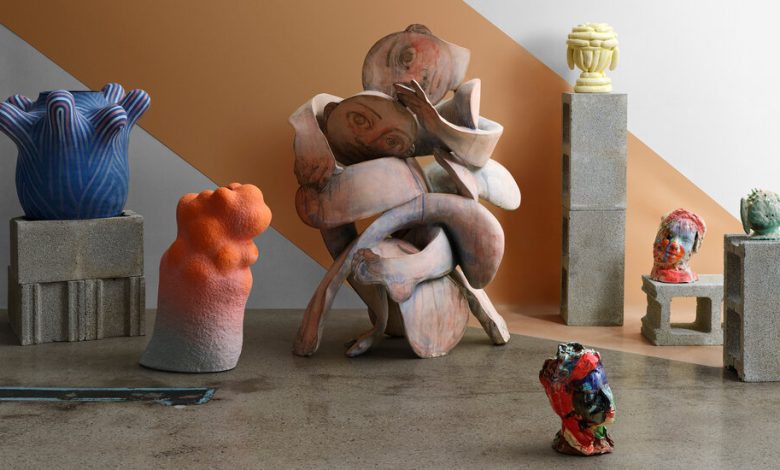The Ceramists Putting a Fresh Spin on Traditional Korean Techniques

The Brooklyn-based ceramic artist Eun-Ha Paek’s pieces are defined by their renegade spirit. A recent work, a foot-high stoneware form, resembles a child’s stick-figure drawing, but with a Surrealist bent: Instead of a head, it has a blue-and-white delftware-style dinner plate; instead of eyes, there are painted butterflies. “I like combining serve ware with food shapes, as if elements of a meal had come together and were having a dinner party,” says Paek, who builds her works’ hollow extremities, including legs that look like hot dogs, with a machine called an extruder and molds other parts by hand before coating the finished forms with cobalt and iron oxide washes and glazes. The pieces reflect Paek’s training in animation, film and video at the Rhode Island School of Design — now in New York, she teaches ceramics at Doclay and at Greenwich House, and illustration at the Parsons School of Design — as well as her upbringing. Born in Seoul, she immigrated to Los Angeles with her family when she was 9 and was dazzled by the new culture she encountered there. “The first place we went was to a drive-through for hamburgers,” she says. “I think my parents saw it as a symbol of having made it, to live in a country where food was brought to your car.”
Paek, 49, belongs to a group of women of Korean descent creating singular American ceramic art. Living everywhere from New York to California, they make experimental sculptures that reflect the traditions and aesthetics of both cultures. “There’s a rich heritage of ceramics in Korea that’s very much centered around incredible craftsmanship, detail and history,” says Jay Oh, 51, the senior director of arts and culture at the Korea Society in Manhattan. “But there’s a group of Korean artists in America who don’t feel the burden of going back to the past or ‘Orientalizing’ their work.” Or as Paek says, “I think in English, but I feel in Korean. It’s a very dramatic and evocative language. In Korean, for example, instead of saying, ‘The soup is boiling,’ you would say the sound the soup makes when it boils. That extraness and whimsy is what I’m hoping to express.”
That’s also true for the Manhattan-based ceramic artist Janny Baek, 50, who was born in Seoul and moved to Flushing, Queens, when she was 3. She earned a B.F.A. in ceramics at RISD but went on to get a master’s degree in architecture at Harvard. “When I was young, I felt the whole point of immigrating to the United States was to have better opportunities and a successful career. I felt like I needed to do something more than be an artist,” Baek says. In 2019, though, five years after she and her husband established their practice, McMahon-Baek Architecture, she returned to ceramics. Baek now creates pieces that resemble amoebic animals or alien life-forms crafted from stained porcelain that she leaves unglazed for a matte, richly pigmented effect.
Besides being fascinated with color, the women are united by their zeal for experimentation, especially when it comes to mixing clay varieties and deploying unorthodox glazing methods. Inherent in ceramics is an element of the unpredictable (clay, after all, is an organic material, and even the most experienced artist will sometimes find herself bedeviled by it), and these makers all embrace the inevitable mistakes and surprises that arise in the process of building and firing their pieces. Raina Lee, 47, who lives in Los Angeles, creates Seussian works thickly coated with custom glazes featuring silicon carbide; the compound triggers reactions that produce textures suggestive of dried lava, dripping icicles or barnacles. Over the years, she has avoided making traditional vessels and vases, her pieces more often resembling decayed versions of those forms or artifacts weathered by the elements of time.
Jennie Jieun Lee, 50, who emigrated from Seoul when she was 4 and now lives between New York and Boston, has a similar affinity for material manipulation. Her clay “paintings,” as she calls them, are squares of glazed stoneware on wood panels inside picture frames, and she makes expressive porcelain busts using classical-style plaster molds bought on eBay. She removes the busts from their molds when they’re mostly set but still wet and flexible, then smears their features, adding blobs of different clays and, finally, dribbling rainbows of gloopy glazes over them to create haunting, melting faces. “My mother was an artist, and we would go to all the museums in New York, seeing minimalism and Abstract Expressionism,” says Lee, who’s now a ceramics professor at her alma mater, the School of the Museum of Fine Arts at Tufts University. “These genres have influenced my work in a big way.”
Though all these artists marry traditional Korean craft with an American free-spiritedness, they each do so differently. For the 32-year-old Soojin Choi, who came to the United States from Changwon, South Korea, for college, the idea of communication, and what can be lost in translation, defines her structurally intricate pieces. Based in Philadelphia, where she’s a resident artist at the Clay Studio, a nonprofit creative center focused on ceramics, Choi makes oversize stoneware sculptures of balloonlike heads that call to mind Surrealist works, and others that feature pairs of human figures with their arms, legs and faces twisted together, pretzel style. “I’m interested in gestures and facial reactions because I believe we can read each other more clearly through body language, especially because I’m always thinking and speaking in two different languages, and not perfectly in either one,” she says. “In some ways, I feel like a foreigner in both Korea and America now — but at the same time, I feel more empathetic for the differences between the countries, too.” It’s a sentiment shared by many of Choi’s contemporaries: that making art can be uniquely poignant when the heart has more than one home.
Photo assistant: Takako Ida. Set designer’s assistant: Steven Ruggiero




